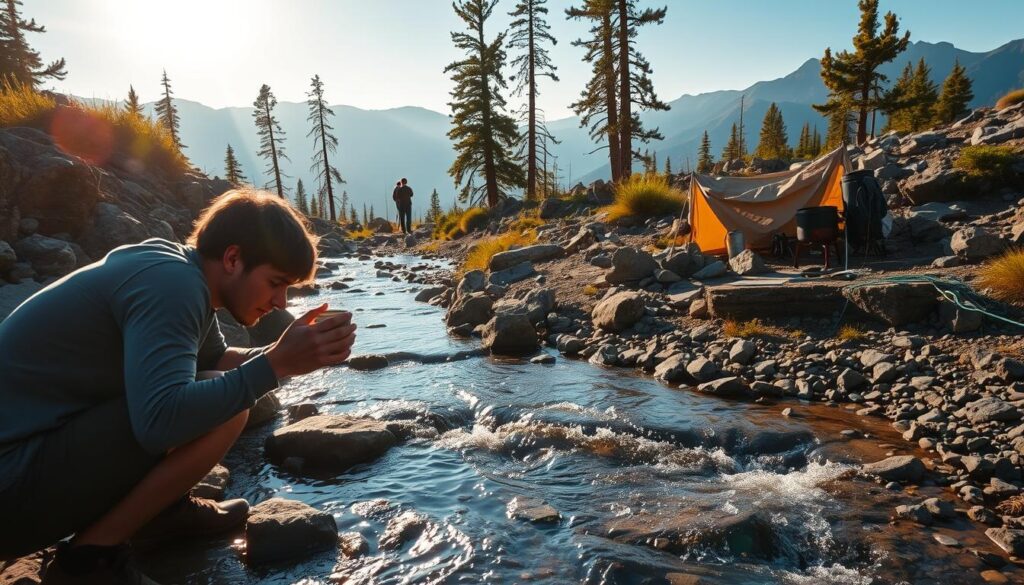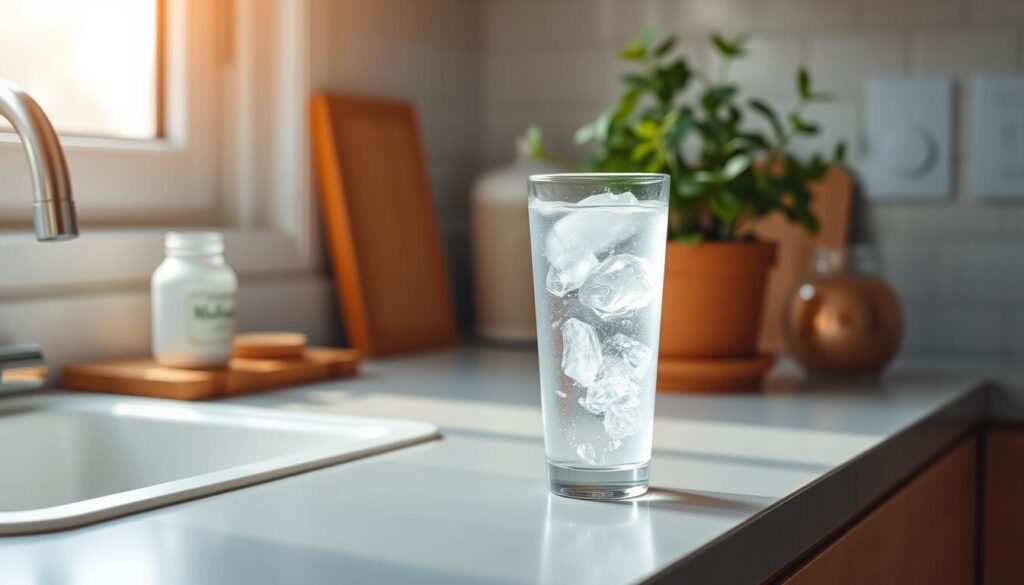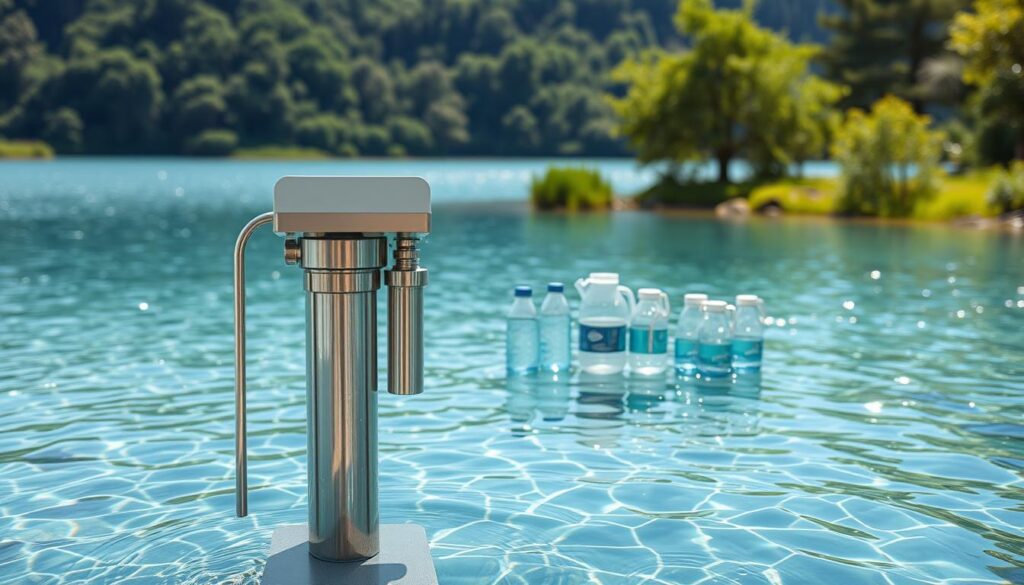When I head into the wilderness, I remember how important hydration is. Water makes up 50% to 70% of our body weight. It’s key for every cell, tissue, and organ to work right.
Staying hydrated is key, not just for everyday life but in survival situations too. Our bodies need water to keep cool, move smoothly, and protect our tissues. Knowing how to stay hydrated can help us stay safe and healthy in tough places.
Key Takeaways
- Understanding the importance of hydration for overall health
- Recognizing the role of water in survival situations
- Learning essential strategies for staying hydrated
- Implementing effective techniques for wilderness survival
- Improving chances of staying safe and healthy in challenging environments
Understanding the Importance of Water in Survival Situations
Knowing how water is key to survival is vital. In any survival situation, having clean drinking water is essential. Water is not just for drinking; it’s also for staying clean and signaling for help.
Why Hydration Matters in the Wild
Staying hydrated is crucial for survival. It affects your body’s performance, thinking, and health. Without enough water, your body can’t do its job well.
Dehydration can make it hard to think clearly. This makes survival even tougher. It also affects your body’s temperature, which is important in extreme weather.
The Consequences of Dehydration
Dehydration can cause serious health problems. These include heat exhaustion, seizures, and organ damage. The severity depends on the environment, how active you are, and your health.
It’s important to know the signs of dehydration early. These include a dry mouth, feeling tired, dizzy, and dark urine. If you see these signs, drink water right away. In severe cases, dehydration can be life-threatening, making understanding water survival techniques crucial.
How Much Water Do I Need?
The amount of water you need changes based on your health, activity level, and where you are. For example, someone who is very active in a hot place needs more water than someone who is resting in a cooler place. Generally, drink at least one liter of water per day, but more in survival situations.
To figure out how much water you need, think about your activity, the weather, and your health. Also, have a plan for emergency water purification. This ensures you can safely use water from sources. Using water purification tablets or other methods can help avoid waterborne illnesses.
Identifying Water Sources in Nature
Finding water in the wild is crucial for survival. Knowing where to look can greatly improve your chances of finding water.
Rivers, Lakes, and Streams: What to Look For
Rivers, lakes, and streams are good places to start looking for water. They are full of life and can be a reliable source. But, it’s important to purify the water first to stay healthy.
Look for these signs of a good water source:
- Vegetation and wildlife nearby
- Clear or moving water
- A clear channel or bank
Rainwater Harvesting Techniques
Rainwater harvesting is a great way to collect water in the wild. It gives you clean water without needing to purify it a lot.
| Technique | Description | Effectiveness |
|---|---|---|
| Using Tarps or Plastic Sheets | Collecting rainwater by creating a slope with a tarp or plastic sheet to guide water into a collection container. | High |
| Creating a Simple Catchment | Forming a depression or using natural formations to collect and store rainwater. | Moderate |
Finding Water in Arid Environments
Finding water in dry areas is hard, but it’s doable. Look for signs of recent water, more plants, and use the solar still method. These can help you find water.
Stay alert and use every trick you know to find water in dry places.
Purifying Water for Safe Consumption
Water purification is key to survival, ensuring you have safe drinking water when needed. In survival situations, clean water is vital for health and avoiding dehydration.
There are many ways to purify water, each with its own benefits. Knowing these methods helps you choose the best way to drink water in the wild or during emergencies.
Boiling: The Most Effective Method
Boiling water is a top choice for purifying it. The CDC says boiling kills bacteria, viruses, and other harmful pathogens. To boil water, heat it to a rolling boil for at least one minute, then let it cool before drinking.
Boiling water has many advantages:
- It’s very effective against many pathogens.
- You only need a heat source, no special equipment.
- It’s easy to do in most survival situations.
Using Water Filters and Purification Tablets
Boiling isn’t the only way to purify water. Water filters and purification tablets are also good options. Filters remove particles and some microorganisms. Tablets contain disinfectants like chlorine or iodine that kill bacteria and viruses.
| Method | Effectiveness | Ease of Use |
|---|---|---|
| Water Filters | Removes particles and some microorganisms | Easy to use, needs maintenance |
| Purification Tablets | Kills bacteria and viruses | Simple, needs waiting time |
Solar Water Disinfection: A Low-Cost Option
Solar Water Disinfection (SODIS) uses sunlight to kill pathogens in water. Fill clear plastic bottles with water and leave them in direct sunlight for at least six hours. The UV rays will disinfect the water.
“SODIS is a simple, effective, and low-cost method for improving the microbiological quality of drinking water.” – World Health Organization
By learning and using these water purification methods, you can greatly lower the risk of waterborne illnesses in survival situations.
Collecting Water: Essential Gear and Techniques
Collecting water is key in outdoor survival. You need the right tools and methods. Having clean drinking water is vital when you’re in the wild.
Portable Water Containers to Carry
A portable water container is crucial. They come in different sizes and materials like plastic, silicone, or stainless steel. I look for ones that are tough, light, and BPA-free.
Collapsible water bottles and hydration bladders are great. They’re easy to carry and store.
| Container Type | Material | Capacity | Weight |
|---|---|---|---|
| Collapsible Water Bottle | Silicone | 1L | 100g |
| Hydration Bladder | Polyurethane | 3L | 200g |
| Stainless Steel Bottle | Stainless Steel | 0.5L | 300g |
Using Clothing and Other Materials to Collect Water
Without special gear, you can still collect water. A clean t-shirt or bandana can filter out debris. You can also use a plastic bag to make a simple solar still.
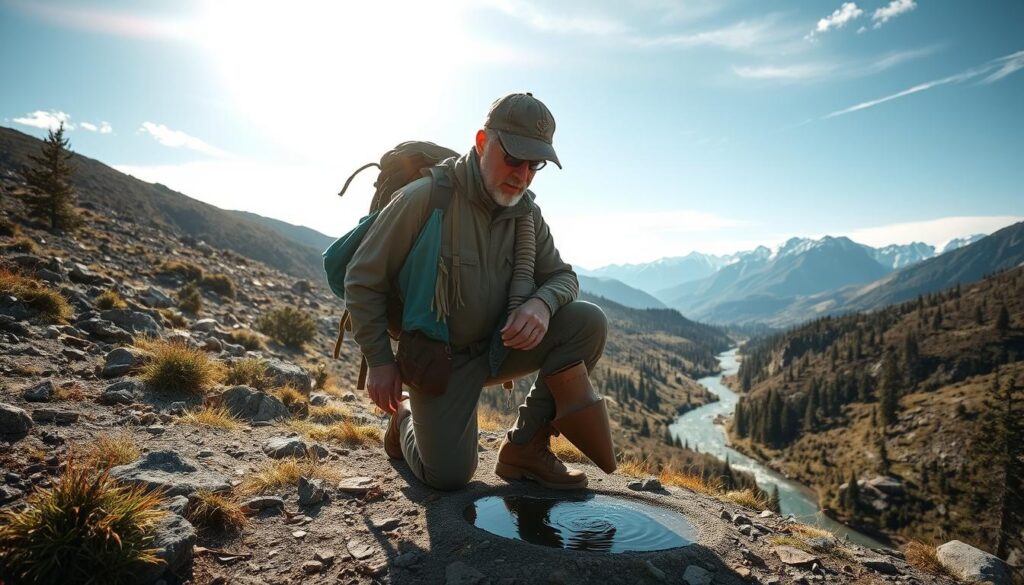
Useful Devices for Outdoor Water Collection
There are tools to make collecting water easier. Water filters and purification tablets make water safe. Water scoops and portable pumps help collect water from different sources.
- Water filters: Remove bacteria, viruses, and particulate matter.
- Purification tablets: Disinfect water using chlorine or iodine.
- Water scoops: Easy to use for collecting water from streams or lakes.
- Portable water pumps: Can be used to filter or pump water from a source.
With the right gear and techniques, you can have clean drinking water in the wild.
Long-Term Water Storage Solutions
Long-term water storage is key for any survival plan. You need to think about the right containers and how to keep them clean. This ensures you have clean drinking water when emergencies last a long time.
Choosing the right containers is crucial. They should be food-grade and made for storing water. This helps avoid contamination.
Container Types for Safe Water Storage
When picking containers, look at the material and how long they last. Here are some good options:
- Plastic bottles: Make sure they are BPA-free and safe for drinking water.
- Stainless steel containers: They’re tough and great for long storage.
- Collapsible water containers: Handy for saving space in emergency kits.
How to Store Water for Extended Periods
To keep water clean for a long time, follow these tips:
- Keep water in a cool, dark spot to stop algae.
- Store containers off the ground to avoid contamination.
- Change your water every 6-12 months to keep it fresh.
Checking for Contamination: Signs to Look For
Check your stored water often for signs of contamination. Look for:
- Visible sediment or particles.
- Unusual smells or tastes.
- Cloudiness or color changes.
If you see any of these, purify the water before drinking it.
Emergency Water Rations: Planning for the Unexpected
Knowing how to ration water is key in emergencies. When disaster hits, finding clean drinking water is hard. Emergency water rations are crucial for survival.
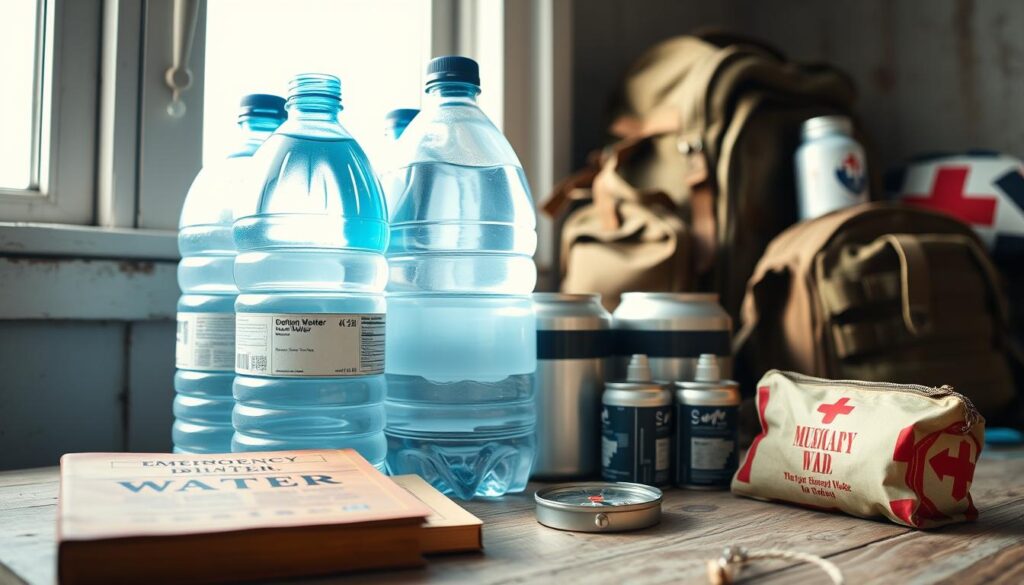
It’s important to pack water for emergency kits. Use containers that are safe, durable, and good for long storage. Choosing the right size and type of water supply depends on household size, climate, and emergency duration.
Pre-Packing Water for Emergency Kits
Here are some tips for pre-packing water:
- Store at least one gallon per person per day for drinking, cooking, and hygiene.
- Use food-grade water containers that are BPA-free and designed for long-term storage.
- Keep water containers in a cool, dark place to prevent algae growth and contamination.
Choosing the Right Size and Type of Water Supply
Choosing the right water supply is about your needs. For example, if you live in a hurricane-prone area, you might need more water. Water purification tablets or filters are also useful for finding water from other sources.
As
“The key to survival is not just having water, but having a plan for accessing and purifying water when needed.”
This shows the importance of being ready with the right tools and knowledge.
When and How to Use Emergency Water Supplies
It’s important to know when and how to use emergency water. Rationing water well can make it last longer. Rationing strategies include drinking only what you need, using purification methods, and cutting down on water for hygiene.
In summary, having a good emergency water plan is vital. By pre-packing water, choosing the right supplies, and knowing how to use them, you can better face unexpected challenges.
Understanding Local Water Regulations and Safety
Local water rules and safety tips are key for survival planning. As a survivalist, knowing the legal and safety sides of water use is important. This ensures I have clean drinking water.
Urban Survival Guidelines
In cities, knowing local water rules is crucial for survival. It’s important to understand guidelines for water use, collection, and purification. For example, using water purification tablets can keep water safe.
Urban survival also means knowing about the community’s water sources. This knowledge helps make smart water use and conservation choices.
State Laws Regarding Water Use and Collection
State laws on water use and collection differ a lot. It’s key to know these laws to avoid legal trouble and have a reliable survivalist water supply. Some states have rules on rainwater harvesting, while others limit water collection from nature.
Knowing these laws helps in planning and conserving water resources.
Protecting Water Resources in My Community
Keeping community water resources safe is everyone’s job. Being careful with water use and reporting any problems helps keep clean drinking water sources safe.
Community efforts and awareness programs are also vital for water conservation. Joining these efforts helps protect water for future generations.
The Role of Water in Food Preparation and Cooking
In outdoor survival, water is not just for drinking. It’s also key for cooking and cleaning. Managing water well is crucial for staying clean and cooking safe, healthy meals.
Water Needs for Cooking and Cleaning
Water is vital in cooking, acting as both an ingredient and a heat carrier. Boiling is a common cooking method, making water essential. Water is also needed for cleaning tools and surfaces, stopping disease spread.
To save water, use it for more than one thing. For example, water for boiling can also clean utensils.
Strategies for Minimal Water Usage
Conserving water is crucial, especially when water is scarce. Choose foods that need little water, like dried or canned items. Using water-efficient cooking methods, like steaming, also cuts down water use.
“Water, water, everywhere, nor any drop to drink” – a phrase from Samuel Taylor Coleriege’s poem “The Rime of the Ancient Mariner” resonates in survival situations where water scarcity is a harsh reality.
Cooking Without Direct Access to Water
When direct water access is not possible, use alternatives. Solar ovens or reflectors can cook food without boiling water. Choosing foods that need little or no water, like grilling or roasting, is also smart.
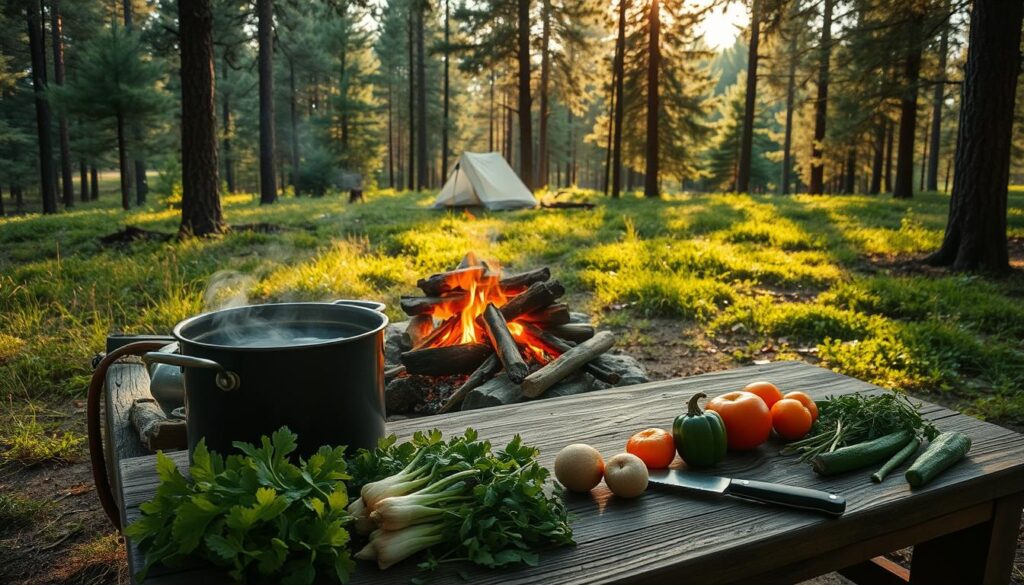
Knowing these strategies boosts survival chances in tough places. It shows water’s big role in cooking and food prep.
Drinking Water Alternatives: What Can I Use?
Survival water isn’t just plain water. There are other options for staying hydrated. Knowing these alternatives is key in survival situations.
Edible plants that hold water are a great alternative. For example, cacti are known to store water for emergencies.
Edible Plants for Hydration
Some plants are better than others for staying hydrated. For example:
- Cactus fruits are a good water source.
- Wild berries offer hydration and antioxidants.
- Leaves from certain plants like Plantago make hydrating tea.
Fruits and Vegetables for Hydration
Fruits and vegetables are also important for hydration. They help keep my water levels up.
Some examples include:
- Watermelon and cucumbers are 92% water.
- Oranges and grapefruits are also very hydrating.
Herbal Teas and Other Beverages
Herbal teas are another option. They hydrate and offer health benefits. For example, peppermint tea helps with digestion, and ginger tea eases nausea.
Using these alternatives helps me stay hydrated when clean water is hard to find. It’s about being smart and knowing what’s available in my environment.
Staying Hydrated During Outdoor Activities
Outdoor adventures like hiking and camping need careful hydration to stay safe and have fun. It’s not just about drinking water. It’s about keeping your body’s fluid balance right, no matter the conditions.
Hydration Tips for Hiking and Camping
When you’re hiking or camping, drink water often. Try to drink at least 1 liter of water per hour of moderate activity in moderate temperatures. But, your needs can change based on your age, weight, and how hard you’re working.
- Check your urine to see if it’s pale yellow or clear. This means you’re drinking enough water.
- Don’t drink too much water at once. This can cause hyponatremia.
- Use a hydration pack or water bottle that’s easy to use and carry.
Recognizing Overexertion and Dehydration
Knowing the signs of dehydration and overexertion is key. Watch for signs like too much thirst, dark urine, dizziness, and feeling tired. If you notice these, it’s time to rest and drink more water.
“Dehydration can really hurt your physical and mental performance, making it a big risk for outdoor fans.”
Adjusting Water Intake for Weather Conditions
The weather affects how much water you need. In hot and humid weather, drink more water because you lose more fluids through sweat. In cold weather, it’s easy to forget to drink water, but it’s still important to stay hydrated to keep your energy up and stay healthy.
- In hot weather, drink more water as needed.
- In cold weather, use insulated water bottles to keep your water from freezing.
- Always be ready to change your hydration plan if the weather changes.
By following these tips and staying informed, you can have a safe and fun outdoor adventure.
Building a Personal Survival Water Plan
Creating a personal survival water plan is key to staying hydrated in unexpected situations. It’s about knowing how much water I need and understanding my surroundings.
Assessing Water Needs and Environment
I first look at my water needs based on the climate, how active I am, and who I’m planning for. Knowing my environment helps me find and store water effectively.
Creating a Step-by-Step Water Strategy
My water strategy involves finding water sources, purifying it, and storing it. This plan makes sure I always have safe drinking water, a crucial outdoor survival tip.
Reviewing and Updating My Survival Plan
It’s important to regularly review and update my survival plan. I check my water storage and adjust my plan as needed due to environmental changes or new information.
FAQ
How much water do I need for survival?
The amount of water needed for survival depends on several factors. These include the climate, how active you are, and your personal needs. It’s best to have at least one gallon of water per person per day. This water is for drinking, cooking, and staying clean.
What are the best methods for purifying water in the wild?
Boiling water is a top method for making it safe to drink. Using water filters and purification tablets are also good options. Solar water disinfection works well when it’s sunny outside.
How can I identify safe water sources in nature?
Look for rivers, lakes, and streams as potential water sources. Always purify the water before drinking it. In dry areas, find spots with lots of greenery or collect dew. Collecting rainwater is another way to get clean water.
What are the signs of dehydration, and how can I prevent it?
Dehydration signs include headaches, feeling very tired, and a dry mouth. To avoid dehydration, drink water often, especially when you’re outside. Adjust how much water you drink based on the weather.
Can I use edible plants and fruits as a source of hydration?
Yes, some plants, fruits, and veggies have water in them and can help with staying hydrated. But, make sure you know what they are and only eat a little bit.
How should I store water for long-term use?
Use containers made for food, keep them clean and sealed well, and store them in a cool, dark spot. Check the water often for any signs of bad stuff, like dirt or weird smells.
What are the best containers for storing water?
Choose containers that are strong and safe for food, like stainless steel or BPA-free plastic. Look for ones with easy-to-use spigots or are made just for storing water.
How can I collect water in outdoor survival situations?
Use water containers, clothes, or other items to catch water. Tools like LifeStraw or Sawyer Mini water filters can also help collect and clean water.
What are some alternatives to plain drinking water?
Herbal teas, coconut water, and other drinks with little sugar can be good alternatives. Eating plants, fruits, and veggies can also help you stay hydrated.
How often should I review and update my survival water plan?
Check and update your water plan every six months. This keeps it current and useful for your needs and where you live.

